

Hibiscus moscheutos is a powerfully ornamental marsh plant with large leaves, sublime flowers, and many sturdy upright stems.
H. moscheutos key facts:
Botanical name – Hibiscus moscheutos
Family – Malvaceae (mallow family)
Type – wet soil perennial
Height – 4 to 6 feet (1.20 to 2 m) or more
Exposure – well-lit
Soil – rich, moist
Foliage : deciduous
Flowering : end of summer
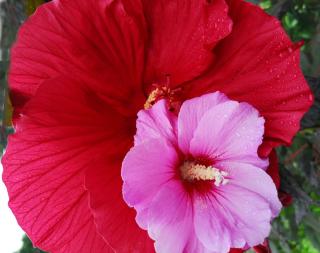 A perennial with deciduous leaves, swamp mallow or Hibiscus moscheutos is a pondside plant that’s perfect to decorate a body of water or a garden basin. In summer, the plant is wreathed in gigantic saucer-shaped flowers (6 inches across or more, 15 cm!).
A perennial with deciduous leaves, swamp mallow or Hibiscus moscheutos is a pondside plant that’s perfect to decorate a body of water or a garden basin. In summer, the plant is wreathed in gigantic saucer-shaped flowers (6 inches across or more, 15 cm!).
They’re generally white with a blood-red center, but sometimes red or pinkish varieties can be found. Hybrids expand the range of colors, and flowers can even reach up to 9 inches across (22 cm).
Swamp mallow should only really be planted outdoors, siding a body of water (slightly acidic water is best).
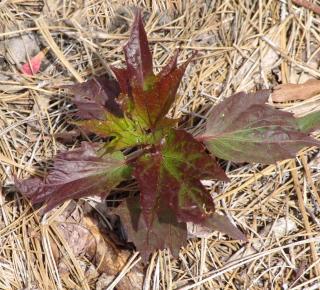 Hibiscus moscheutos is quite a large shrub, massive in fact, that is best as a standalone. The feature that most gardeners love about it is the astounding blooming (September). Nonetheless, they’ll also fit together with other shrubs in a shrub bed if the space permits, but each plant will need its own spot, they won’t grow very well if they’re crowded together: at least 3 feet to all sides (1 meter).
Hibiscus moscheutos is quite a large shrub, massive in fact, that is best as a standalone. The feature that most gardeners love about it is the astounding blooming (September). Nonetheless, they’ll also fit together with other shrubs in a shrub bed if the space permits, but each plant will need its own spot, they won’t grow very well if they’re crowded together: at least 3 feet to all sides (1 meter).
These plants also cope with clay, mud and shallow sitting water. Interestingly, they’re also pretty tolerant to drought once they’ve settled in well.
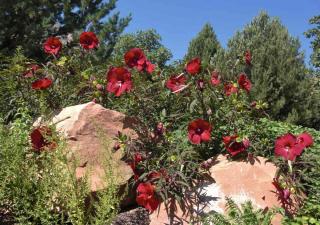 The showy flowers of Hibiscus moscheutos will draw the eyes in an aquatic garden setting. Such plants also grow well in containers, they’re placed to attract butterflies in parks, around vacation homes, in wet, marshy landscaping, low-maintenance gardens, as perennial edges and in humid areas.
The showy flowers of Hibiscus moscheutos will draw the eyes in an aquatic garden setting. Such plants also grow well in containers, they’re placed to attract butterflies in parks, around vacation homes, in wet, marshy landscaping, low-maintenance gardens, as perennial edges and in humid areas.
Try pairing Hibiscus moscheutos with Asclepias incarnata, Eupatorium fistulosum, Helianthus angustifolius, Lobelia cardinalis and Panicum virgatum.
Again, make note of the size of this plant: it may quickly block the sun out from nearby flowers and crops.
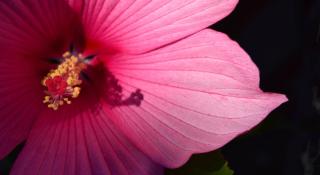 Shrubby shoots (that don’t branch out) surge out from the roots; they die back in winter. In winter, it’s important to cover the plant (what’s left of it underground) with a thick layer of dead leaves, especially if it freezes in your area. This relatively hardy plant, when mulched, will survive freezing down to 23°F (-5°C), and even a bit colder if only for one night.
Shrubby shoots (that don’t branch out) surge out from the roots; they die back in winter. In winter, it’s important to cover the plant (what’s left of it underground) with a thick layer of dead leaves, especially if it freezes in your area. This relatively hardy plant, when mulched, will survive freezing down to 23°F (-5°C), and even a bit colder if only for one night.
Stems are sturdy and only rarely need staking. Cut them back to ground level at the end of winter: this favors the emergence of new, fresh growth.
The hibiscus clusters start growing quite late in the season. Young plants, less than a year old, require regular, deep watering, without ever letting the soil get dry.
Hibiscus moscheutos multiplies easily through seed sowing, clump division, and cuttings.
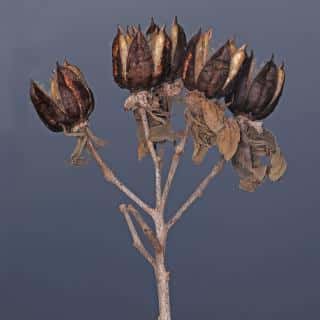 Sowing: seed pods ripen and turn brown within 4 to 5 weeks after the blooming. The seeds are ready for harvest when they’re dark brown. If needed, cull out any seeds that are infested with weevils, and keep the healthy ones in a container in a cools spot: you can sow them in the middle of spring the following year. Sow in soil mix that you keep consistently moist, with lots of nutrients. Not soggy, just moist.
Sowing: seed pods ripen and turn brown within 4 to 5 weeks after the blooming. The seeds are ready for harvest when they’re dark brown. If needed, cull out any seeds that are infested with weevils, and keep the healthy ones in a container in a cools spot: you can sow them in the middle of spring the following year. Sow in soil mix that you keep consistently moist, with lots of nutrients. Not soggy, just moist.The solitary flowers appear at the junction of the topmost leaves. Each bloom only lasts for a day, but new ones appear repeatedly for about a month. Seed pods appear that are 1 to 2 inches across (3 to 5 cm).
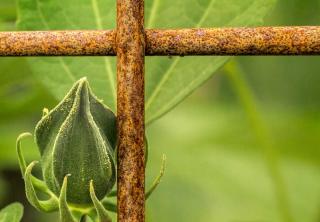 Swamp hibiscus is occasionally attacked by the Japanese beetle and by sawfly larvae that leave only the veins of leaves behind, making it look like the skeleton of a leaf. If these pests are problematic, try to find organic solutions that won’t harm beneficial pollinators.
Swamp hibiscus is occasionally attacked by the Japanese beetle and by sawfly larvae that leave only the veins of leaves behind, making it look like the skeleton of a leaf. If these pests are problematic, try to find organic solutions that won’t harm beneficial pollinators.
This tall plant is moderately vulnerable to leaf spot, leaf scorch, rust and canker.
Healthy plants grown in a favorable environment won’t need any staking.
Flowers always open between 9 and 11 am. This is the reason why Hibiscus moscheutos is used as a “flower clock” in the New York Botanical gardens.
The oversized exotic-seeming flowers are pollinated by native bees. On the plants, a host of different caterpillars find food and shelter, including a few different types of moths.
Hibiscus coccineus is a relative that has similar blooming. It shares the same growing conditions. Pink forms of Hibiscus moscheutos that don’t have the crimson red center were originally thought to be Hibiscus palustris. Today, these are simply considered a colored version of H. moscheutos.